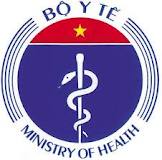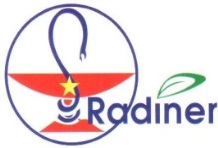CHINESE MEDICINE JOURNAL
Book 33 No. 12 - June 2008
Ta Hai Nguyen1, Lai Thuat1, Hoang Kien Xuan1, Tuong Vi Chiet1, Quach Tung Sieu1, Hoang Nhan Ban1, Nguyen Phu Kieu2, Pham Kim Man2, Tran Dinh Binh2
(1. Guangxi Medical University, Department of Pharmacology Teaching research, Naning Guangxi 530021;
2. Critical diseases Research and Treatment Institutes of Vietnam, Hanoi - Vietnam)
ABSTRACT
Purpose:
To observe the effect of Cedemex to the content of cAMP and cGMP at different brain regions on sewer-rat detoxicated morphine under the effect of Naloxone.
Method:
- Establishing 8 experimental groups, each group includes 10 sewer-rats.
Group 1: Control group
Group 2: Normal Cedemex control group
Group 3: Group stopping using morphine
Group 4: Group continuing to use morphine
Group 5: Group using Cedemex with high dose, 8mg/kg/day
Group 6: Group using Cedemex with normal dose, 4mg/kg/day
Group 7: Group using Cedemex with low dose, 2mg/kg/day
Group 8: Group comparing positive medicine, taking Ich An medicine
- Building the model of rat addicted to morphine by the method of increasing the dose gradually, hypodermic injection with morphine in 7 days.
- Using the method of testing radioactive immunity to measure the content of cAMP and cGMP at the regions of VTA, cerebral cortex and hippocampus.
Results:
- Cedemex has effect of stabilizing the symptoms of detoxication on sewer-rat addicted to morphine (P<0.05).
- Comparing to the control group, the group continuing to use morphine has ability to increase cAMP content, reduce cGMP content at the regions of VTA, cerebral cortex and hippocampus on sewer-rat addicted to morphine (P<0.05).
- Using Cedemex in short term reduces cAMP content, increases cGMP content clearly at the regions of VTA, cerebral cortex and hippocampus on sewer-rat detoxicated morphine
Conclusion: Cedemex has effect of stabilizing the symptoms of detoxication on sewer-rat addicted to morphine; the mechanism has effect because Cedemex participates in regulating the process of producing cAMP and cGMP content in brain tissue.
[Key words] Cedemex, morphine addiction, symptom of detoxication syndrome, cAMP am cGMP
[Number sign of Chinese document classification] R285.5; [Document code] A;
[Number sign of article on magazine] 1001-5302(2008)12-1439-05
Cedemex is the medicine supporting to stop the attack of drug addiction researched and manufactured by Institute for research and treatment of dangerous diseases of Vietnam; the medicine has the form of tablet, is prepared from many types of herbal remedy such as goldthread, eucommia ulmoide… over 10 types of herbal remedy. In Vietnam, the medicine was applied to support stopping the attack of addiction for thousands of people addicted to drug of Opiates group and have good effect of detoxication. The experimental study on animal of the author in the previous period shows that Cedemex has effect of treating the symptoms of detoxication syndrome on sewer-rat detoxicated morphine [1], at present, it is not known clearly whether the effect of this treatment relates to the change of cAMP and cGMP content or not. We, through the method of testing radioactive immunity, carry out the measurement of cAMP, cGMP content at different brain regions of sewer-rat addicted to morphine, observe the effect of Cedemex to cAMP, cGMP content in the brain of sewer-rat detoxicated morphine, thereby, carry out deeper research on the ability to stabilize the symptoms of detoxication syndrome.
1. Material:
1.1 Animal:
SD sewer-rat, female, weight 180 ~ 220g, under the standard on experimental animal No. SYKG Guangxi 2003-0005, provided by Animal Experiment Center, Quangxi Medical University.
1.2 Medicine and testing medicine:
- Cedemex, in form of capsule, is manufactured by Institute for research and treatment of dangerous diseases of Vietnam, each capsule contains 500mg full glue (including: goldthread, eucommia ulmoide, rhizoma rhehmaniae…).
Before using, take 80 capsules to dissolve in 30ml warm water, then add 10ml distilled water prepared with content of 1g/ml, this solution is pumped into the stomach (ig);
- Morphine clohydrat injection solution, Tham Duong pharmacy workshop No. 1, batch No. 20040604;
- Positive comparison medicine which is selected to use namely Ich An drinking solution was permitted to manufacture and consume by the State of China, Thien Dai Pharmacy Company Limited (Chau Hai), circulation license No. Z20020032, approval No. G50101.
- Naloxone: Ich Kieu Medicine Production Company Limited (Hunan), batch No. 20040319.
- Testing medicine set for measuring cAMP and cGMP radioactive immunity, bought at isotope laboratory, Shanghai Medical College.
1.3 Machine in service of experiment: Fully automatic radioactive immunity gamma ray counter GC - 911 of Experiment Science and Technology Corporation, University of Science and Technology of China.
2. Method
2.1 Building the mode of sewer-rat addicted to morphine in 7 days [2]:
From the first day to the seventh day, carry out as follows:
- Control group and Normal Cedemex group have hypodermic injection twice a day with sodium chloride (NS);
- Other groups apply the method of gradually increasing dose by carrying out the hypodermic injection with morphine for sewer-rat, the dose of each day is 20, 40, 60, 80, 100, 100, 100mg/kg respectively, hypodermic injection twice a day at the back (sc).
2.2 Group division and medicine distribution:
The groups are treated differently in 5 days; the experiment from the 8th day to 12th day is carried out as follows:
- Control group: continue the hypodermic injection at back region with NaCl 0.9% in 5 days continuously;
- Normal Cedemex group: twice a day, pump Cedemex into the stomach with the dose of 8g/kg (2 days), 4g/kg (2 days), and 2g/kg (1 day);
- The groups after the final time of using morphine are divided randomly into 6 groups:
+ Group stopping using morphine: stop using morphine and twice a day, have hypodermic injection at back region with NaCl 0.9%, in 5 days continuously;
+ Group continuing to use morphine: have injection with morphine 100mg/kg/day, in 5 days continuously;
+ Group using Cedemex with high dose 8g/kg, pump into the stomach in 5 days continuously;
+ Group using Cedemex with normal dose 4g/kg, pump into the stomach in 5 days continuously;
+ Group using Cedemex with low dose 2g/kg, pump into the stomach in 5 days continuously;
+ Group taking Ich An solution: twice a day, pump into the stomach, each time with 0.001, 0.0005, 0.00025 mL/g, in total, using in 5 days.
2.3 Observing symptom of detoxication syndrome and sampling:
On the 13th experimental day, 8 sewer-rat groups above were injected Naloxone into abdomen cavity (4mg/kg) to promote detoxication syndrome. Using the evaluation method by giving Machi-chi-su point [3] and observing sewer-rat groups within 1 hour to appear objective criteria such as: salivation, grinding the teeth, diarrhea… and the state of losing weight (giving point once every 15 minutes). Taking note the average point of the syndrome of detoxication syndrome in 1 hour, then killing all sewer-rats, taking the brain, separating the brain at different brain regions in low temperature condition, then putting in the Ependoff 1.5ml test-tube, preserving in the fridge at -80oC and waiting for measurement, see table 1.
Table 1: Method of evaluation by giving point according to Machi-Chi-Su
|
Syndrome of detoxication syndrome |
Once every 15 minutes, evaluation by giving point, evaluating in 1 hour |
|
Abnormal position
|
Licking the hair, washing the face, erecting the hair, licking the genitals, standing straightly, curved tail (2 points) |
|
Activation reduction |
Closer (1 point), depending (2 points) |
|
Run |
Not continuous (1 point), continuous (2 points) |
|
Grinding the teeth |
Not continuous (0.5 points), continuous (1 point) |
|
Anxiety
|
Aggressive (0.5 points), incessantly butt into iron cage, want to escape from cage mildly (0.5 points), incessantly butt into iron cage, want to escape from cage clearly (1 point) |
|
Eyelid collapse |
(1 point) |
|
Lacrimation |
(4 points) |
|
Diarrhea |
Soft stool (4 points), liquid stool (8 points) |
|
Salivation |
Mild (1 point), clear (2 points) |
|
Weight loss |
< 2% (2 points ), 2%-4% (5 points), 4%-6% (10 points), 6%-8% (15 points), >8% (20 points) |
2.4 Measuring the content of cAMP and cGMP by method of testing radioactive immunity:
Take about 50mg of separated brain organization preserved in the fridge at the temperature of -80oC, after weighing, put it in 10ml test-tube in which there are 2 ml of buffering solution namely acetic acid 50mmol/l (pH4.70) which was cooled. Take the brain organization to grind finely into hanging solution and put into another 10ml test-tube, use 2ml of ethylic alcohol 75% to wash the grinding machine once, then use such alcohol into hanging solution, mix evenly, keep it intact in 5 minutes, centrifuge in 15 minutes at the temperature of 4oC with speed of 3500 rpm, take clear solution part at upper part to pour into another 10ml test-tube, then use 2ml ethylic alcohol 75% to wash the precipitated part, mix evenly, continue to centrifuge in 15 minutes at the temperature of 4oC with speed of 3500 rpm. Combine with clear solution above dried in drying cabinet 60oC, wait until it is dry, take the deposit to preserve in the fridge at 4oC in order to wait for measurement. Then, in accordance with the instructions of the box, carry out the measurement on radioactive immunity and calculate the concentration of cAMP and cGMP, the unit is pmol/g.
2.5 Data processing:
Use the data statistic software SPSS 10.0, experimental data is shown by ![]() ±s, compare the average value of the groups by ANOVA error analysis method (single factor), use S-N-K for double comparison, if P<0.05, that means there is statistically significant difference.
±s, compare the average value of the groups by ANOVA error analysis method (single factor), use S-N-K for double comparison, if P<0.05, that means there is statistically significant difference.
3. Results:
3.1 Cedemex treated in short term has effect of stabilizing the symptoms of detoxication syndrome on sewer-rat addicted to morphine under the promotion of Naloxone
After promoting the rat to be addicted to morphine by Naloxone, there will be symptoms of detoxication syndrome and weight loss (P<0.05), it proves the successful establishment of model of sewer-rat addicted to morphine. Compare to the group stopping using morphine, 3 groups using Cedemex with dose of 8, 4, 2g/kg have effect of inhibiting clearly the symptoms of detoxication syndrome (through evaluation point) on sewer-rat addicted to morphine under the promotion of Naloxone, the group using the dose of 8, 4g/kg has ability to prevent the weight loss clearly in one hour (P<0.05). For results, see table 2
Table 2: Evaluation point of symptoms of detoxication syndrome and rate of weight loss of sewer-rat groups (![]() ±s, n=10)
±s, n=10)
|
Group distribution |
Dose /g/kg |
Evaluation point of symptom of stopping the attack |
Body weight/g |
Change rate /% |
|
|
Pre-promotion |
Post-promotion |
||||
|
Control |
- |
0 |
195.25±5.91 |
194.50±6.19 |
0 |
|
Normal Cedemex |
- |
0 |
210.05±5.91 |
211.02±6.21 |
0 |
|
Stop using morphine |
- |
70.25±10.271) |
190.75±9.91 |
178.75±12.86 |
61) |
|
Continue to use morphine |
- |
52.00±4.101.2) |
188.25±27.04 |
176.75±22.51 |
61) |
|
Cedemex
|
8 |
51.63±3.331.2) |
183.25±17.73 |
175.00±15.77 |
41.2) |
|
4 |
53.00±5.241.2) |
206.88±19.21 |
196.75±19.16 |
41.2) |
|
|
2 |
55.54±2.311.2) |
183.25±17.73 |
175.00±15.77 |
51) |
|
|
Drink Ich An solution |
- |
53.00±10.391.2) |
206.88±19.21 |
196.75±19.16 |
41.2) |
Note: Compare to control group (1) P<0.05; Compare to the group stopping using morphine(2) P <0.05 (tables 3 - 5 are similar)
3.2 Effect of Cedemex to cAMP content at different brain regions on sewer-rat detoxicated morphine
Comparing to the control group, normal Cedemex group almost has no effect to cAMP content at the regions of VTA, cerebral cortex and hippocampus. The difference does not have statistic significance. And for the group stopping using morphine, cAMP content at the regions of VTA, cerebral cortex and hippocampus increases clearly in comparison with the control group (P<0.05); For the group continuing to use morphine, cAMP content at 3 brain regions has the maximum increase amplitude. Compared to the group stopping using morphine, 3 groups using Cedemex with dose of 8, 4, 2 g/kg have ability to reduce cAMP content in the parenchyma at 3 regions of VTA, cerebral cortex and hippocampus (P<0.05). For the results, see the table.
Table 3: Changing cAMP content at brain regions relating to sewer-rat addicted to and detoxicated morphine (![]() ±s,n=10)
±s,n=10)
|
Group distribution |
Dose /g/kg |
VTA/pmol/g |
Cerebral cortex /pmol/g |
Hippocampus /pmol/g |
|
Control |
- |
11 964.70±321.16 |
15 164.80±347.80 |
14 878.60±782.91 |
|
Normal Cedemex |
- |
12 035±232.14 |
14892.00±2347.68 |
14 110.52±383.29 |
|
Stop using morphine |
- |
12 332.17±122.75 |
16 062.25±754.86 |
16 427.39±667.07 |
|
Continue to use morphine |
- |
13 155±857.051.2) |
17923.79±777.851.2) |
17 576.78±874.051.2) |
|
Cedemex
|
8 |
11 216.66±871.742) |
13 326.56±688.202) |
11 761.87±774.282) |
|
4 |
11 532.66±661.742) |
13 912.32±465.322) |
13 652.18±368.352) |
|
|
2 |
11 716.66±831.252) |
14 564.65±615.202) |
15 761.87±647.152) |
|
|
Drink Ich An solution |
|
11 532.66±661.742) |
13 754.16±512.322) |
13 561.21±352.242) |
3.3 Effect of Cedemex to cGMP content at different brain regions on sewer-rat detoxicated morphine
Normal Cedemex group almost has no effect to cGMP content, and compared to the control group, it does not have statistic significance. And for the group stopping using morphine and the group continuing to use morphine, cGMP content at the regions of VTA, cerebral cortex and hippocampus reduces clearly in comparison with the control group (P<0.05); In which, for the group continuing to use morphine, cGMP content at 3 brain regions has the maximum decrease amplitude; compared to the group stopping using morphine, 3 groups using Cedemex with dose of 8, 4, 2 g/kg have ability to increase clearly cAMP content at 3 regions of VTA, cerebral cortex and hippocampus (P<0.05); at the same time, it presents clear dose relation. For the results, see table 4.
Table 4: Change in cGMP content at brain regions relating to sewer-rat addicted to and detoxicated morphine (![]() ±s,n=10)
±s,n=10)
|
Group distribution |
Dose /g/kg |
VTA/pmol/g |
Cerebral cortex /pmol/g |
Hippocampus /pmol/g |
|
Control |
- |
850.25±74.05 |
721.56±72.53 |
635.56±40.51 |
|
Normal Cedemex |
- |
820.25±39.56 |
710.33±68.36 |
626.58±38.64 |
|
Stop using morphine |
- |
728.71±11.551) |
706.67±16.581) |
600.43±11.241) |
|
Continue to use morphine |
- |
689.86±53.761.2) |
604.58±53.751.2) |
525.01±7.491.2) |
|
Cedemex
|
8 |
984.32±12.542) |
954.68±22.642) |
769.12±22.482) |
|
4 |
932.98±15.862) |
922.63±15.752) |
719.00±21.362) |
|
|
2 |
909.50±17.652) |
915.73±18.572) |
669.08±25.842) |
|
|
Drink Ich An solution |
|
932.98±13.682 |
932.51±13.352) |
719.00±23.252) |
3.4 Change in cAMP/cGMP rate at brain regions relating to sewer-rate addicted to and detoxicated morphine (pmol/g)
For the sewer-rat group stopping using morphine, continuing to use morphine, cAMP/cGMP rate at 3 regions of VTA, cerebral cortex and hippocampus increases clearly in comparison with the control group (P<0.05); 3 Cedemex groups with high, normal and low dose can recover normally cAMP/cGMP rate at 3 regions of VTA, cerebral cortex and hippocampus (P<0.05) and they present clear dose relation. For the results, see table 5.
Table 5: Change in cAMP/cGMP rate at brain regions relating to sewer-rate addicted to and detoxicated morphine (![]() ±s, n=10)
±s, n=10)
|
Group distribution |
Dose/g/kg |
VTA |
Cerebral cortex |
Hippocampus |
|
Control |
- |
14.07±2.36 |
21.02±0.40 |
23.41±2.29 |
|
Normal Cedemex |
- |
14.67±2.33 |
20.96±0.35 |
22.52±2.16 |
|
Stop using morphine |
- |
16.92±2.331) |
24.73±2.351) |
27.36±1.751) |
|
Continue to use morphine |
- |
19.07±2.361.2) |
29.65±4.921.2) |
33.48±4.161.2) |
|
Cedemex group
|
8 |
11.40±3.58 |
13.96±4.75 |
15.29±5.002) |
|
4 |
12.36±2.45 |
15.08±3.89 |
18.99±4.582) |
|
|
2 |
12.88±3.58 |
15.90±4.75 |
23.56±5.002) |
|
|
Drink Ich An solution |
|
12.36±2.45 |
14.75±3.89 |
18.86±4.582) |
4. Discussions:
At present, the majority of authors believe that the increased adaptability of cAMP system participated in the generation and development of dependence and tolerance of Opi group, at the same time, finally the body attains the balance of new pathological state [4-9]. This experiment uses the method of gradually increased dose to establish the model of rat addicted to morphine in 7 days and uses 3 doses of Cedemex to observe the treatment effect of Cedemex for symptoms of detoxication syndrome on sewer-rat addicted to morphine. The result shows clearly that the use of Cedemex with the dose of 8, 4, 2g/kg has effect of stabilizing clearly the symptoms of detoxication syndrome on sewer-rat addicted to morphine. Especially, the doses of Cedemex 8g/kg and 4g/kg give better effect. Cedemex with dose of 8g/kg and 4g/kg also has effect of preventing the weight loss in 1 hour due to the antagonistic reaction of stopping the attack. At the same time, discover high content of cAMP in the model of addicted rat, low content in normal group, similarly as the change situation on evaluation point of symptoms of detoxication syndrome. Therefore, cAMP content is thought to be higher than the normal level, it can indirectly prove the establishment of successful model.
For the group stopping using morphine and the group continuing to use morphine, cAMP content increases highly, cGMP content reduces lowly in the parenchyma of the regions of cerebral cortex and hippocampus, and the group continuing to use morphine changes the most clearly; it shows the existence of the increase level of cAMP and decrease level of cGMP in brain tissue on sewer-rat detoxicated morphine. It is in accordance with the reported document [4-9]. These changes are adaptability changes of the central nerve after using addictive drug again and again. The increase of cAMP system may be due to the compensation on long-term effect and information feedback for the issue that morphine controls cAMP system and leads to the presentation at gene, it is the bio-chemical basis for creating the phenomenon of depending and tolerating morphine and substances of same type; and the decrease of cGMP level in the brain of sewer-rat addicted to and detoxicated morphine proved that the use of morphine in long term affects to cGMP in the nerve centre, mainly being the effect of inhibition; the mechanism of this issue is still pending for further research. Somebody observed that cGMP level increasing highly in the brain or cerebrospinal fluid can increase seriously the symptoms of detoxication syndrome; Using inhibition enzyme guanylate cyclase (GC) can decrease slowly the symptoms of detoxication syndrome on sewer-rat addicted to and detoxicated morphine [10-11]. This thing may relate to the factors such as: method of establishing the addicted animal model, type of animal, method of using medicine, making specimen, checking division and different methods… its reason needs deeper reference.
It is shown in these study results that Cedemex with treatment in short term can reduce clearly cAMP content, increase clearly cGMP content at different regions on sewer-rat detoxicated morphine and cAMP/cGMP rate is recovered normally, in which the group using Cedemex with dose of 8g/kg and 4g/kg has the clearest change. Cedemex, through some regimes of inhibiting enzyme adenylate cyclase (AC), has ability to decrease cAMP content and through other signal transmission mechanism, increase cGMP content in the brain cell tissue.
It can be explained through the experimental results that Cedemex inhibits the detoxication response through regulating the content of cAMP, cGMP in the brain of sewer-rat detoxicated morphine for implementation. Therefore, the ability to regulate the content of cAMP and cGMP of Cedemeex may be an important molecule mechanism in stabilizing the symptoms of detoxication syndrome.
Reference
{1} Ta Hai Nguyen, Lai Thuat, Hoang Kien Xuan - intervention and treatment effect of Cedemex for symptom of stopping the use of drug for rat depending on morphine. Magazine of Guangxi Medical University, 2007, 24(2); 231.
{2} Co San Chi, Ly Sinh Vu, effect of experimental factors for the construction of model of rat depending on morphine {J}. Magazine of Tay An University of Transport; medical version, 2003, 25 (5): 446;
{3} Machi Yanaghita, Keko Nakamura, Teka Wasu, Addictive formation of reliever injected many times and human body {J} Clinic research newspaper before experimental research, 1979,5:139.
{6} Ly Vi Nham, Tu Kien Quoc, mechanism of nerve molecule addicted to drug {J} Medical research magazine, 2003,16 (2): 135.
{11} Duong Nham Linh, Luu Tu Binh, Khau Hoc Tai, effect of No-cMGP central system for symptom of stopping morphine {J} Psychological medical magazine of China, 2000, 14: 110.
Translator: Tran Loc - Hanoi University of Pharmacy.
MA. MD. Kieu To Uyen - Radiner Institute







